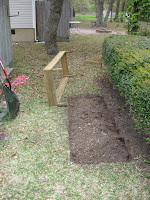Disclaimer: I am a neophyte vegetable gardener. This year marks only my third year in the trenches (potatoes very much on my mind this morning).
Growing edibles is not my forte, for two reasons:
1) I hate to cook.Iif I can’t eat it raw, my interest-level wanes. I also harbor semi-repressed memories of Augusts spent sweltering over vats of boiling water in an air-conditionless kitchen, helping my mom put up the tons of tomatoes Daddy’s garden produced and produced and produced. Not to mention the gallons of cucumbers dilled, sweeted and piccalillied and, one unforgettable year, bushels of peaches. (I bet Mom still has a jar or two of those peaches. Seems to me a few of them exploded after a decade or so in the cupboard over the refrigerator, but I could be mistaken.)
2) Tim thinks vegetables, except for carrots and corn, are evil. And corn gives him the cripes. Sitting across the table from me as I type, he reminds me that that “evil vegetables” snark is not strictly true. By his reckoning, anything non-animal and non-mineral is by definition vegetable, including potatoes, cashews, chocolate, sugar, Doritos and all other grain and candy products.
Just so you know the extent of our oddness: we don’t own a microwave, don’t subscribe to cable TV, have no doorbell or one of those kitchen sink sprayers-on-a-hose that always end up leaking. It has been whispered about that the Fitzgeralds are a bit odd.
These little peculiarities of ours should not, however, deter you.
Nonetheless, my spring enthusiasms infect my darling and handy husband to the extent that he offers to abet me in producing even more edibles that I won’t cook and he doesn’t like. On Friday and Saturday, we added 20 square feet of raised beds for me to plant.
I’ve looked at the raised-bed “systems” offered for sale in the catalogs and at the home-improvement emporia. None meets my criteria for sturdiness, likely longevity and non-use of petroleum products. We Fitzes build our own.
Materials are simple, and cheap. For our two two-by-six boxes, we stockpiled the following:
· 4 1x6”x8’ boards (We use pressure treated. It’s no longer infused with arsenic chromate, and is alleged to be safe. Because of a life-long habit of eating apple seeds, I’m immune to arsenic anyway. Besides, termites can digest an untreated frame in two years.)
· 8 18” lengths of 2x2” (that comes to two 8-footers, with four feet left over)
· About 50 2½” deck screws
From here, we’re going pictorial.
1. Assemble materials.
2. The most important tool of all,
who saws 2' off each board,
leaving 6' for the long side.
3. Clamp the frame into shape.
4. Pre-drill holes, then drive 2 screws into each corner.
5. Clamp each corner brace/anchor as shown, and
secure with 2 screws on each leg of the angle.
Repeat to assemble the second bed.
6. Have Bobo the Fat Lady
help you clear the
vegetation from the
area the raised
vegetation from the
area the raised
bed is to end up.
9. Clear and edge the second bed area.
10. Place the second frame in the
second bed as shown.
11. Admire the effect for a minute…
12. …tap the anchoring legs into the ground until the sides of the frame touch the ground. Aim for level, but don't obsess about it.
The main advantage of planting in raised beds is that you control of the soil. Next time (if a paycheck arrives in timely fashion), we’ll do just that.
Thanks for dropping by. Looking forward to your comments, questions and suggestions.
Kathy












Staying tuned for the next installment. Here in Flat Top we are holding onto faith that spring will arrive. So much faith, that I am about to be supplanted (sic) by the seedlings abounding in our home. In the meantime, we will be planting the bounty of our fruit-full foray into Bristol, Virginia yesterday. Plums, Peaches and Pears, Oh My! Cherries, berries and currants awry. I dream of the day I can tiptoe through the trees and eat my pleaure.
ReplyDeleteThe raised beds look great, and I will be watching closely. Enjoy your blog so much!Thanks for sharing the bounty of your knowledge.